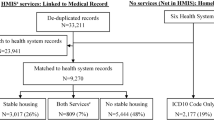Abstract
Variation between homeless populations due to socioeconomic and environmental factors necessitates tailoring medical, health policy, and public health interventions to the unique needs of the homeless population served. Despite the relatively large size of the homeless population in Florida, there is a paucity of research that characterizes the homeless population who frequent homeless clinics within the state. This project describes the demographics, disease prevalence, and other risk factors among homeless individuals in Tampa, Florida. We conducted a retrospective chart review on adult homeless patients seen in 2015 and 2016 at two free clinic sites operated by Tampa Bay Street Medicine, a medical student-run organization from the University of South Florida in Tampa, Florida. Rates of diseases and substance use were recorded and Charlson Comorbidity Index (CCI) was calculated to assess mortality risk. Of the 183 homeless patients in this study, 34.4% reported hypertension, 13.7% reported diabetes, 27.1% reported a respiratory disease, 5.6% reported hyperlipidemia, and 32.8% reported a psychiatric disorder. Tobacco use was reported by 65.6% of patients, 32.2% reported alcohol use, and 17.5% reported illicit drug use. CCI was positively associated with age. Females reported higher rates of anemia, anxiety, chronic obstructive pulmonary disease, and psychiatric disorders. Hypertension, diabetes, certain respiratory diseases, and mental health disorders were more prevalent in the homeless population than in the general population in Tampa, Florida. Homeless women appeared to have higher morbidity than homeless men. Rates of tobacco and illicit drug use were significantly higher whereas alcohol use was lower in the study population than the general population. This study underscores the critical need for mental health initiatives, substance abuse treatment programs, and women’s health programs that are accessible to the homeless in Tampa.
Similar content being viewed by others
References
Henry, M., Watt, R., Rosenthal, L., & Shivji, A. (2017). The 2017 Annual Homeless Assessment Report (AHAR) to Congress. The U.S. Department of Housing and Urban Development Office of Community Planning and Development.
Nazworth, S. (2017) Council on Homelessness 2017 Report. Florida Council on Homelessness.
Point-in-Time Count FL-501 Tampa/Hillsborough County CoC Tampa Hillsborough Homeless Initiative, 2017.
Tampa/Hillsborough County CoC 2017 Homeless Point-in-Time Count. Tampa Hillsborough Homeless Initiative, 2017.
Health Care and Homelessness NCH Fact Sheet #8 (2006). National Coalition for the Homeless.
Lebrun-Harris, L. A., Baggett, T. P., Jenkins, D. M., Sripipatana, A., Sharma, R., Hayashi, A. S., et al. (2013). Health status and health care experiences among homeless patients in federally supported health centers: Findings from the 2009 patient survey. Health Services Research, 48(3), 992–1017.
Brown, R. T., Kiely, D. K., Bharel, M., & Mitchell, S. L. (2012) Geriatric syndromes in older homeless adults. Journal of General Internal Medicine, 27, 16–22.
Fazel, S., Geddes, J. R., & Kushel, M. (2014). The health of homeless people in high-income countries: Descriptive epidemiology, health consequences, and clinical and policy recommendations. Lancet, 384(9953), 1529–1540.
Cesari, W. A., Vaikunth, S. S., Lewis, J. B., & Panda, M. (2012). Know your audience: Analysis of chief complaints at clinica esperanza, a student-run free clinic in Memphis, Tennessee. Journal of Primary Care & Community Health, 3(4), 295–298.
Lu, K. B., Thiel, B., Atkins, C. A., Desai, A., Botwin, A., Povlow, M. R., et al. (2018). Satisfaction with healthcare received at an interprofessional student-run free clinic: Invested in training the next generation of healthcare professionals. Cureus, 10(3), e2282.
Shinn, G. (2014). The cost of long-term homelessness in Central Florida: The current crisis and the economic impact of providing sustainable housing solutions. Central Florida Commission on Homelessness.
Hahn, J. A., Kushel, M. B., Bangsberg, D. R., Riley, E., & Moss, A. R. (2006). BRIEF REPORT: The aging of the homeless population: Fourteen-year trends in San Francisco. Journal of General Internal Medicine, 21(7), 775–778.
Smith, S. M., McAuliffe, K., Hall, J. M., McDonough, C. W., Gurka, M. J., Robinson, T. O., et al. (2018). Hypertension in Florida: Data from the OneFlorida Clinical Data Research Network. Preventing Chronic Disease, 15, E27.
Diabetes Data and Statistics. (2018). United States Diabetes Surveillance System, Division of Diabetes Translation, CDC.
Rui, P., & Okeyode, T. (2015). National Ambulatory Medical Care Survey: 2015 State and National Summary Tables.
Summary Health Statistics: National Health Interview Survey. (2016). U.S. Department of Health and Human Services, Centers for Disease Control and Prevention, National Center for Health Statistics.
Polonsky, W. H., & Henry, R. R. (2016). Poor medication adherence in type 2 diabetes: Recognizing the scope of the problem and its key contributors. Patient Preference and Adherence, 10, 1299–1307.
CDC Report. (2013). Mental illness surveillance among U.S. adults. Centers for Disease Control and Prevention.
Carroll, M. (2014). Council on Homelessness 2014 Report. Florida Council on Homelessness.
Brody, D. J., Pratt, L. A., & Hughes, J. P. (2018). Prevalence of depression among adults aged 20 and over: United States, 2013–2016. NCHS Data Brief (303): 1–8.
Fazel, S. (2008). The prevalence of mental disorders among the homeless in western countries: Systematic review and meta-regression analysis. PLoS Medicine 5, e225.
2015 National Survey on Drug Use and Health (NSDUH). Table 2.41B—Alcohol use in lifetime, past year, and past month among persons aged 12 or older, by demographic characteristics: Percentages, 2014 and 2015. Substance Abuse and Mental Health Services Administration (SAMHSA).
Jamal, A., Phillips, E., Gentzke, A. S., Homa, D. M., Babb, S. D., King, B. A., et al. (2018). Current cigarette smoking among adults—United States, 2016. Centers for Disease Control and Prevention, Morbidity and Mortality Weekly Report (MMWR).
Florida Drug Control Update. (2013). Executive Office of the President of the United States.
Author information
Authors and Affiliations
Corresponding author
Rights and permissions
About this article
Cite this article
Pribish, A., Khalil, N., Mhaskar, R. et al. Chronic Disease Burden of the Homeless: A Descriptive Study of Student-Run Free Clinics in Tampa, Florida. J Community Health 44, 249–255 (2019). https://doi.org/10.1007/s10900-018-0580-3
Published:
Issue Date:
DOI: https://doi.org/10.1007/s10900-018-0580-3




